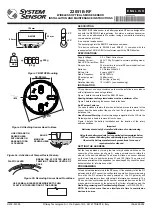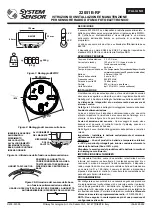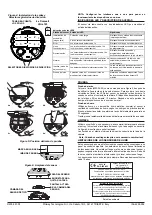
D200-301-00
I56-4224-002
Pittway Tecnologica S.r.l. Via Caboto 19/3, 34147 TRIESTE, Italy
≤
M4
50-60 mm
107 mm
+
=
246 g
(66 g)
132 g
48 g
-30°C
40°C
B501RF
32 mm
104
mm
62 mm
DESCRIPTION
The 22051E-RF radio sensor is a battery operated RF device designed for
use with the M200G-RF radio gateway. It contains a wireless transceiver
and runs on an addressable fire system (using a compatible proprietary
communication protocol).
It is an optical smoke sensor.
The sensor plugs into the B501RF wireless sensor base.
This device conforms to EN54-25 and EN54-7. It complies with the
requirements of 2014/53/EU for conformance with the RED directive.
SPECIFICATIONS
Supply Voltage:
3.3 V Direct Current max.
Standby Current:
@ 3V: 120 µA (typical in normal operating mode)
Red LED Current Max: 4mA
Re-sync time:
35s (max time to normal RF communication from
device power on)
Batteries:
4 X Duracell Ultra123
Battery Life:
4 years @ 25
o
C
Radio Frequency:
865-870 MHz;
RF output power:
14dBm (max)
Range:
500m (typ. in free air)
Relative Humidity:
10% to 93% (non-condensing)
INSTALLATION
This equipment and any associated work must be installed in accordance
with all relevant codes and regulations.
Figure 1 details the installation of the B501RF base.
Spacing between radio system devices must be a minimum of 1m
Figure 2 details attaching the sensor head to the base.
Anti-Tamper Features
The base includes a feature that, when activated, prevents removal of the
sensor from the base without the use of a tool. See Figures 3a and 3b for
details on this.
Head Removal Warning -
An alert message is signalled to the CIE via the
Gateway when a head is removed from its base.
Figure 4 details the battery installation and the location of the rotary
address switches.
Important
Batteries should only be installed at the time of commissioning
Warning
Using these battery products for long periods at temperatures below
-20°C can reduce the battery life considerably (by up to 30% or more)
Observe the battery manufacturer’s precautions for use and
requirements for disposa
l
SETTING THE ADDRESS
Set the loop address by turning the two rotary decade switches on the
underside of the sensor (see figure 4), using a screwdriver to rotate the
wheels to the desired address. The device will take one sensor address
on the loop. Select a number between 01 and 159 (Note: The number of
addresses available will be dependent on panel capability, check the panel
documentation for information on this).
PROGRAMMING
To load network parameters into the RF sensor, it is necessary to link the RF
gateway and the RF sensor in a configuration operation. At commissioning
time, with the RF network devices powered on, the RF gateway will
connect and programme them with network information as necessary. The
RF sensor then synchronises with its other associated devices as the RF
mesh network is created by the gateway. (For further information, see the
Radio Programming and Commissioning Manual
- ref. D200-306-00.)
NOTE:
Do not run more than one interface at a time to commission
devices in an area.
22051E-RF
WIRELESS OPTICAL SMOKE SENSOR
INSTALLATION AND MAINTENANCE INSTRUCTIONS
E N G L I S H
Figure 1: B501RF Mounting
Figure 2: Attaching Sensor Head to Base
Figure 3a: Activation of Tamper Resist Feature
PLASTIC LEVER
BREAK TAB AT DOTTED LINE BY
TWISTING TOWARDS CENTRE OF
BASE
Figure 3b: Removing Sensor Head From Base
USE A SMALL-BLADED SCREWDRIVER TO PUSH
PLASTIC IN THE DIRECTION OF THE ARROW
LINE UP MARK ON
SENSOR HEAD
WITH BULGE ON
BASE AND TURN
CLOCKWISE
BULGE
MARK ON
SENSOR HEAD
I 56- 4224- 002




























